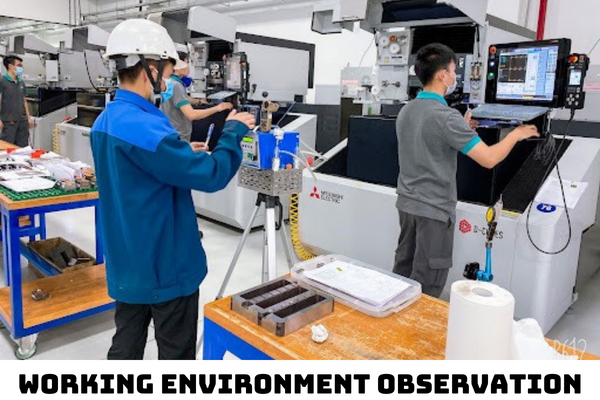Vietnam: What are the principles for carrying out the working environment observation? What are the conditions for working environment observation organizations?
What are the principles for carrying out the working environment observation in Vietnam?
According to Article 35 of Decree 44/2016/ND-CP stipulating the principles to carry out the working environment observation in Vietnam as follows:
Principles to carry out the working environment observation
1. Carrying out the observation of all harmful factors listed in the occupational sanitation dossier prepared by the labor establishment.
For heavy and dangerous and particularly heavy and dangerous jobs, upon working environment observation, it is required to assess the occupational burden and some ergonomic psychophysiological indicators specified in Paragraph 3, Article 33 of this Decree.
2. The working environment observation is done in line with the plan made between the labor establishment and the organization eligible for carrying out the working environment observation.
3. The working environment observation must ensure:
a) Implementation during the time the labor establishment is conducting its business and production;
b) Sampling by the method of personal sampling and the site of sampling is located at the area potentially affecting the employees;
c) For working environment observation by the method of quick detection when the result is not sure, the working environment observation shall take a sample and analyze it by the appropriate method in the standard laboratory.
4. The harmful factors need to be observed and assessed and updated in the occupational sanitation dossier in the following cases:
a) There is a change of technological procedure, production procedure or upon renovation or upgrading of labor establishment but with potential risks of new harmful factors for the employee’s health.
b) The working environment observation organization makes additional recommendations when carrying out the working environment observation;
c) As required by the competent state management bodies.
5. The working environment observation organization shall receive the payment of cost of working environment observation; assess the occupational exposure, make a report and the management fees shall be paid by the employer as stipulated by law.
6. The working environment observation organization shall report to the Ministry of Health or Department of Health on the harmful factors newly detected or generated at the labor establishment without regulation on permitted limits.

What are the conditions for working environment observation organizations in Vietnam?
Pursuant to Article 33 of Decree 44/2016/ND-CP amended by Clause 19, Article 1 of Decree 140/2018/ND-CP stipulating the conditions of working environment observation organizations in Vietnam as follows:
3. Has facilities, equipment, instruments, chemicals and capacity to ensure the following minimum requirements:
a) Monitor harmful elements of the occupational environment
70% of the following elements must be completed:
- Measurement, testing and analysis of microclimate elements, including temperature, humidity, wind speed and thermal radiation on the site and in the laboratory;
- Measurement, testing and analysis of physical elements, including light, noise, vibration frequency, radiation, electromagnetic field and ultraviolet radiation on the site and in the laboratory;
- Assessment of occupational exposure elements, including microorganisms, allergy, sensitivity and solvent;
- Assessment of occupational burden and some ergonomics indicators: physical occupational burden, neuropsychological burden and ergonomic occupational position.
- Collection of sample, storage, measurement and testing of dust on the site and analysis of dust in the laboratory, analysis of concentration of silica in dust, metal dust, coal dust, talc dust, cotton dust and asbestos dust;
- Collection of sample, storage, measurement and testing of chemical elements, including NOx, SOx, CO, CO2, organic solvents (benzene and homologues - toluene, xylene), mercury, arsenic, TNT, nicotine and pesticide on the site, and analysis thereof in the laboratory.”
b) Adopt a plan and procedure for storage, use, maintenance, inspection and calibration of equipment in accordance with regulations of the competent authority or the manufacturer if the competent authority does not lay down any regulations;
c) Adopt a procedure for use and operation of equipment for collecting and storing samples, measurement, testing and analysis of occupational environment.
d) Having a head office with enough area to ensure the quality of working environment observation; the conditions of the laboratory must meet the quality requirements in sample preservation, processing and analysis.
dd) Having sufficient personal protective equipment upon carrying out the working environment observation;
e) Taking measures to ensure the industrial hygiene, fire prevention and safety, biological and chemical safety and strict compliance with the collection, transport, storage and treatment of waste in accordance with regulations of law.
What are the regulations on psychological, physiological and ergonomic agents in Vietnam?
At the same time, the dossier of working environment sanitation is specified in Appendix I issued together with Decree 39/2016/ND-CP as follows:
List of harmful factors existing in work environment
5. Psychological, physiological and ergonomic agents
- Neuropsychological burden assessment:
- Ergonomic assessment:
In case an enterprise employs employees doing hazardous heavy work or jobs, in addition to the harmful factors listed in the dossier of working environment sanitation, it must also carry out the neuropsychological burden assessment and the ergonomic assessment.
Thư Viện Pháp Luật
